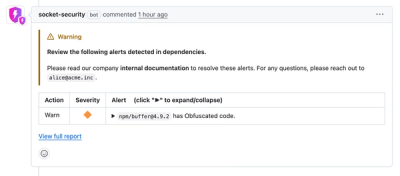
Security News
Crates.io Users Targeted by Phishing Emails
The Rust Security Response WG is warning of phishing emails from rustfoundation.dev targeting crates.io users.
kademlia-routing-table
Advanced tools
XOR based routing table used for P2P networks such as a Kademlia DHT.
XOR distance based routing table used for P2P networks such as a Kademlia DHT.
npm install kademlia-routing-table
Similar to k-buckets, but implemented using the simplifications described in https://github.com/ethereum/wiki/wiki/Kademlia-Peer-Selection
To understand the concept behind peer routing, DHTs, and the terms used here, I recommend reading the Kademlia DHT paper as well.
const RoutingTable = require('kademlia-routing-table')
const { randomBytes } = require('crypto')
// Create a new table that stores nodes "close" to the passed in id.
// The id should be uniformily distributed, ie a hash, random bytes etc.
const table = new RoutingTable(randomBytes(32))
// Add a node to the routing table
table.add({
id: randomBytes(32), // this field is required
// populate with any other data you want to store
})
table.on('row', function (row) {
// A new row has been added to the routing table
// This row represents row.index similar bits to the table.id
row.on('full', function (node) {
// The row is full and cannot be split, so node cannot be added.
// If any of the nodes in the row are "worse", based on
// some application specific metric then we should remove
// the worst node from the row and re-add the node.
})
})
// Get the 20 nodes "closest" to a passed in id
const closest = table.closest(randomBytes(32), 20)
table = new RoutingTable(id, [options])Create a new routing table.
id should be a Buffer that is uniformily distributed. options include:
{
k: 20 // The max row size
}
bool = table.add(node)Insert a new node. node.id must be a Buffer of same length as table.id.
When inserting a node the XOR distance between the node and the table.id is
calculated and used to figure which table row this node should be inserted into.
Returns true if the node could be added to the corresponding row or false if not.
If false is returned the onfullrow function is invoked for the corresponding row and node.
node = table.get(id)Get a node from the table using its id. Returns null if no node has the passed in id.
bool = table.has(id)Returns true if a node exists for the passed in id and false otherwise.
nodes = table.closest(id, [maxNodes])Returns an array of the closest (in XOR distance) nodes to the passed in id.
id should be Buffer of same length as table.id. Per default at max k
nodes are returned, but this can be configured using the maxNodes argument.
This method is normally used in a routing context, i.e. figuring out which nodes in a DHT should store a value based on its id.
bool = table.remove(id)Remove a node using its id. Returns true if a node existed for the id and
was removed and false otherwise.
node = table.random()Get a random node from the table.
nodes = table.toArray()Returns all nodes from table as an array. If you create a new routing table from these nodes it will be identical to the used here.
table.on('row', row)Emitted when a new row is added to the routing table. At max, bitLength(table.id)
will exist.
table.rowsA fixed size array of all rows in the table. Normally you would not need to worry about accessing rows directly outside the row event.
For the row passed in the the onfullrow function the following API exists.
row.indexThe row index. Represents how many prefix bits are shared between nodes in the row and the table id.
row.nodesA list of all the nodes in the row, sorted by their id.
row.dataProperty set to null initially you can use if you want to store optional data on the row.
bool = row.add(node)Same as table.add but for a specific row. Only use this to add the newNode
passed in onfullrow function.
bool = row.remove(node)Same as table.remove but for a specific row. Only use this to remove the
"worst" node from the row when wanting to add the newNode.
row.on('add', node)Emitted when a new node is added to this row.
row.on('remove', node)Emitted when a node has been removed from this row.
row.on('full', node)Emitted when a node wants to be added to this row, but the row is full (stores k nodes).
When this happens you should check if any of the nodes already in the row (row.nodes) are
"worse" than the passed node. If that is the case, remove the "worst" one and re-add the node passed in the arguments.
Various algorithms can be implemented to handle full rows, which is why the routing table leaves most of this logic up to the user. These kind of algorithms include adding the rejected node to a cache and wait for another node in the row to be removed before trying to insert it again, or using an LRU cache to determine which node already in the row has been heard from yet.
MIT
FAQs
XOR based routing table used for P2P networks such as a Kademlia DHT.
We found that kademlia-routing-table demonstrated a healthy version release cadence and project activity because the last version was released less than a year ago. It has 1 open source maintainer collaborating on the project.
Did you know?

Socket for GitHub automatically highlights issues in each pull request and monitors the health of all your open source dependencies. Discover the contents of your packages and block harmful activity before you install or update your dependencies.

Security News
The Rust Security Response WG is warning of phishing emails from rustfoundation.dev targeting crates.io users.

Product
Socket now lets you customize pull request alert headers, helping security teams share clear guidance right in PRs to speed reviews and reduce back-and-forth.

Product
Socket's Rust support is moving to Beta: all users can scan Cargo projects and generate SBOMs, including Cargo.toml-only crates, with Rust-aware supply chain checks.